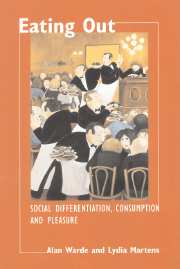Book contents
- Frontmatter
- Contents
- List of illustrations
- List of tables
- Acknowledgements
- 1 Studying eating out
- Part I Modes of provision
- Part II Access
- 4 Patterns of eating out
- 5 Domestic organisation, family meals and eating out
- Part III Delivery
- Part IV Enjoyment: the attractions of eating out
- Part V Conclusion
- Methodological appendix: data collection and analysis
- References
- Index
4 - Patterns of eating out
Published online by Cambridge University Press: 22 September 2009
- Frontmatter
- Contents
- List of illustrations
- List of tables
- Acknowledgements
- 1 Studying eating out
- Part I Modes of provision
- Part II Access
- 4 Patterns of eating out
- 5 Domestic organisation, family meals and eating out
- Part III Delivery
- Part IV Enjoyment: the attractions of eating out
- Part V Conclusion
- Methodological appendix: data collection and analysis
- References
- Index
Summary
There are many different types of place to eat. One important question is who uses different places and how often they go. As sociologists we are initially very interested in the social and cultural characteristics of people who behave differently. Such characteristics indicate the financial, social, practical and cultural forces, systematically distributed across the population, which constrain or encourage people to engage in particular ways of eating out.
It would be surprising if the very poor spent the same on eating out as the rich. However, sociologically it would be very unusual if income were the only relevant feature of differences. Earlier commentaries have identified other factors which affect eating out. For example, it has been maintained that women are discouraged from eating out (Wood, 1990; Finkelstein, 1989). Eating out also has class connotations. It was a practice severely restricted by social class until at least the middle of the twentieth century. It has generally been thought that the significance of class declined thereafter. Thus, for instance, Burnett (1989: 264, 318) says that it was only in the inter-war period that the lower middle classes began to eat out and that it was some time after the Second World War that the practice became more or less universal. Also, it is the principal thesis of Mennell (1985) that social differences in food consumption behaviour have been in long-term decline: the ‘diminishing contrasts’ of age, region and season, but particularly of class, have accompanied increased variety of available foodstuffs.
- Type
- Chapter
- Information
- Eating OutSocial Differentiation, Consumption and Pleasure, pp. 69 - 91Publisher: Cambridge University PressPrint publication year: 2000

